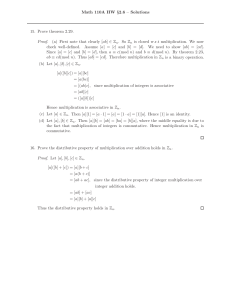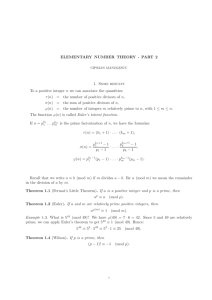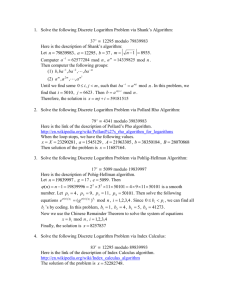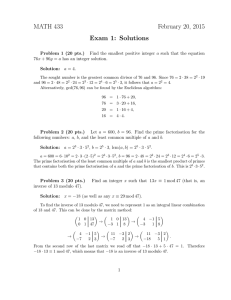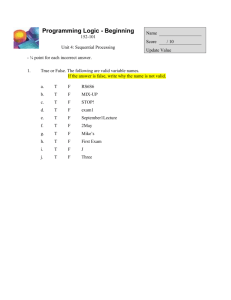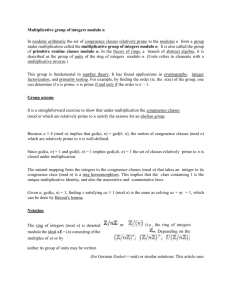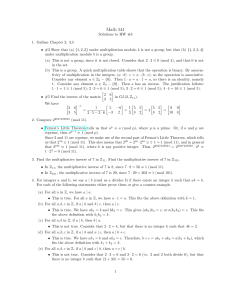Sample Exam #1
advertisement
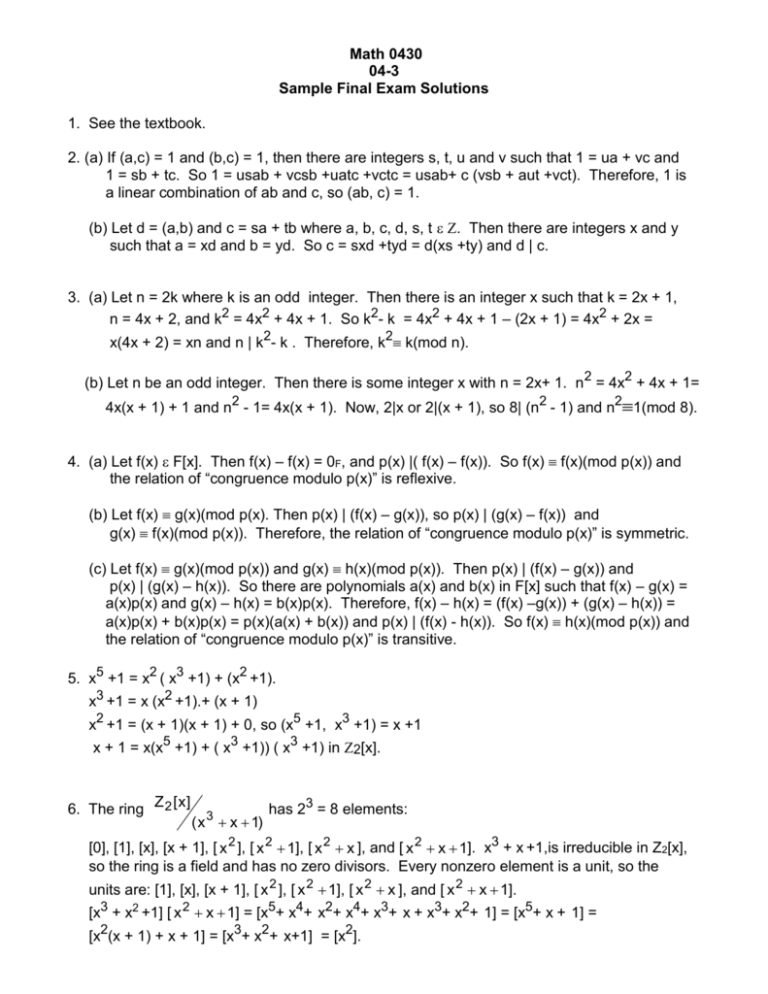
Math 0430
04-3
Sample Final Exam Solutions
1. See the textbook.
2. (a) If (a,c) = 1 and (b,c) = 1, then there are integers s, t, u and v such that 1 = ua + vc and
1 = sb + tc. So 1 = usab + vcsb +uatc +vctc = usab+ c (vsb + aut +vct). Therefore, 1 is
a linear combination of ab and c, so (ab, c) = 1.
(b) Let d = (a,b) and c = sa + tb where a, b, c, d, s, t . Then there are integers x and y
such that a = xd and b = yd. So c = sxd +tyd = d(xs +ty) and d | c.
3. (a) Let n = 2k where k is an odd integer. Then there is an integer x such that k = 2x + 1,
n = 4x + 2, and k2 = 4x2 + 4x + 1. So k2- k = 4x2 + 4x + 1 – (2x + 1) = 4x2 + 2x =
x(4x + 2) = xn and n | k2- k . Therefore, k2 k(mod n).
(b) Let n be an odd integer. Then there is some integer x with n = 2x+ 1. n 2 = 4x2 + 4x + 1=
4x(x + 1) + 1 and n2 - 1= 4x(x + 1). Now, 2|x or 2|(x + 1), so 8| (n2 - 1) and n21(mod 8).
4. (a) Let f(x) F[x]. Then f(x) – f(x) = 0F, and p(x) |( f(x) – f(x)). So f(x) f(x)(mod p(x)) and
the relation of “congruence modulo p(x)” is reflexive.
(b) Let f(x) g(x)(mod p(x). Then p(x) | (f(x) – g(x)), so p(x) | (g(x) – f(x)) and
g(x) f(x)(mod p(x)). Therefore, the relation of “congruence modulo p(x)” is symmetric.
(c) Let f(x) g(x)(mod p(x)) and g(x) h(x)(mod p(x)). Then p(x) | (f(x) – g(x)) and
p(x) | (g(x) – h(x)). So there are polynomials a(x) and b(x) in F[x] such that f(x) – g(x) =
a(x)p(x) and g(x) – h(x) = b(x)p(x). Therefore, f(x) – h(x) = (f(x) –g(x)) + (g(x) – h(x)) =
a(x)p(x) + b(x)p(x) = p(x)(a(x) + b(x)) and p(x) | (f(x) - h(x)). So f(x) h(x)(mod p(x)) and
the relation of “congruence modulo p(x)” is transitive.
5. x5 +1 = x2 ( x3 +1) + (x2 +1).
x3 +1 = x (x2 +1).+ (x + 1)
x2 +1 = (x + 1)(x + 1) + 0, so (x5 +1, x3 +1) = x +1
x + 1 = x(x5 +1) + ( x3 +1)) ( x3 +1) in 2[x].
6. The ring
Z 2 [ x]
3
( x x 1)
has 23 = 8 elements:
[0], [1], [x], [x + 1], [ x 2 ], [ x 2 1], [ x 2 x ], and [ x 2 x 1]. x3 + x +1,is irreducible in Z2[x],
so the ring is a field and has no zero divisors. Every nonzero element is a unit, so the
units are: [1], [x], [x + 1], [ x 2 ], [ x 2 1], [ x 2 x ], and [ x 2 x 1].
[x3 + x2 +1] [ x 2 x 1] = [x5+ x4+ x2+ x4+ x3+ x + x3+ x2+ 1] = [x5+ x + 1] =
[x2(x + 1) + x + 1] = [x3+ x2+ x+1] = [x2].
a b
a b
| a, b R}. Show that S is an ideal of the ring T = {
| a, b, c R}
7. Let S = {
0 0
0 c
0 0
a b c d
r s
, T . Then
S. Let
,
S and
Proof: S is nonempty since
0 t
0 0
0 0 0 0
a b c d a c b d
a b r s ar as bt
r s a b
S,
=
· S, and
-
=
=
0
0
0 t 0 0
0 0 0 0 0
0 0 0 t 0
ra rb
S. So S is an ideal of T
0 0
8. Show that 5 = (5) is a prime ideal of , but 10 = (10) is not.
Proof. If a, b such that ab (5), then 5 | ab. Since 5 is prime, 5|a or 5|b. This implies
that a (5) or b (5). Therefore, (5) is a prime ideal of .
2·5 10, but 2 10 and 5 10 , so 10 is not a prime ideal of .
9. A homomorphism : 2 is defined by (z) = [r] where z = 2q + r, 0 r < 2 as in the
Division Algorithm. Find the kernel of and express it as a principal ideal of .
Proof: Note that [z] = [r] here. Let K be the kernel of . Then K = { z | (z) = [0]} =
{z | [r] = [0]} = { z | [z] = [0]} = {z | (2 | z)} = (2).
10. Define multiplication on Z3 Z3 by (a,b) (c,d) = (ac – bd, bc + ad) Complete the
multiplication table for Z3 Z3 , noting that the multiplication is commutative. Is this the
multiplication table of an integral domain? Of a field? Justify your answers.
(0,0)
(0,0)
(0,0)
(0,1)
(0,0)
(0,2)
(0,0)
(1,0)
(0,0)
(1.1)
(0,0)
(1,2)
(0,0)
(2,0)
(0,0)
(2,1)
(0,0)
(2,2)
(0,0)
(0,1)
(0,0)
(2,0)
(1,0)
(0,1)
(2,1)
(1,1)
(0,2)
(2,2)
(1,2)
(0,2)
(1,0)
(0,0)
(0,0)
(1,0)
(0,1)
(2,2)
(0,2)
(0,2) (1,2)
(1.0) (1,1)
(2.2) (0,1)
(1,2) (2,0)
(1,1)
(2,1)
(2,1)
(2,2)
(1,1)
(0,0)
(2,1)
(1,2)
(1,1)
(2,0)
(2,2)
(1,0)
(0,1)
(1,2)
(0,0)
(1,1)
(2,2)
(1.2) (2.0) (0,1)
(2,1)
(0,2)
(1,0)
(2.0) (0,0)
(2.1) (0,0)
(0,2)
(2,2)
(0,1)
(1,1)
(2.0) (2,2)
(2.1) (1,0)
(2,1)
(1,2)
(1,0)
(1,2)
(1,2)
(0,1)
(1,1)
(2,0)
(2,2)
(1,2)
(2,1)
(2,2)
(1,0)
(1,1)
(2,0)
(0,1)
(0,0)
(0,2)
(0,1)
This is the multiplication table of an integral domain because there are no zero divisors. It is
the multiplication table of a field because a finite integral domain is a field or because every
nonzero element has a multiplicative inverse.

